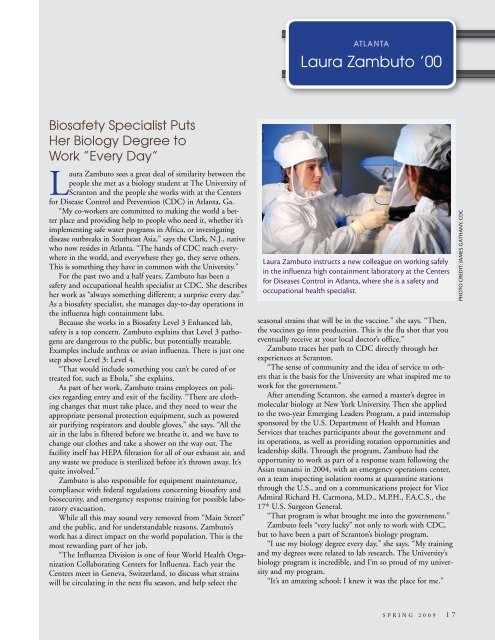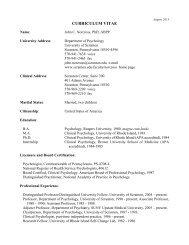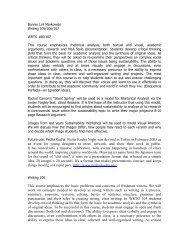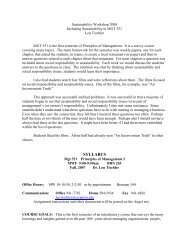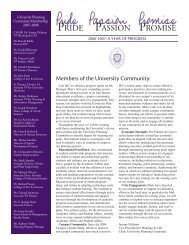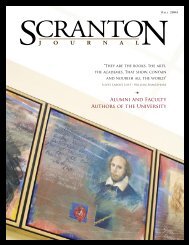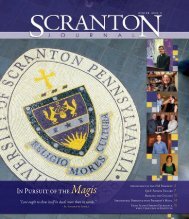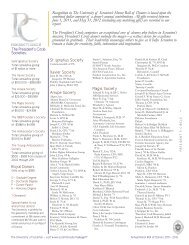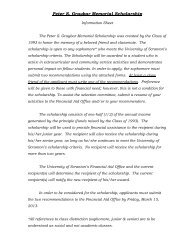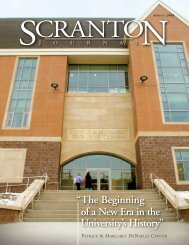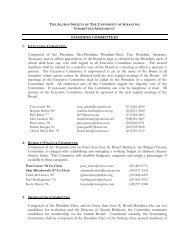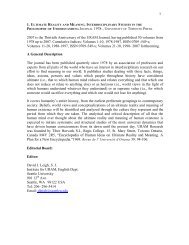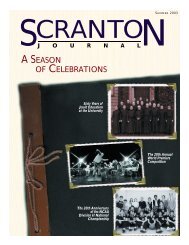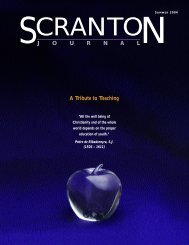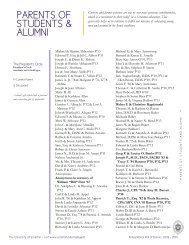SPrING 2009 - The University of Scranton
SPrING 2009 - The University of Scranton
SPrING 2009 - The University of Scranton
Create successful ePaper yourself
Turn your PDF publications into a flip-book with our unique Google optimized e-Paper software.
atlanta<br />
Laura Zambuto ’00<br />
Biosafety Specialist Puts<br />
Her Biology Degree to<br />
Work ”Every Day”<br />
Laura Zambuto sees a great deal <strong>of</strong> similarity between the<br />
people she met as a biology student at <strong>The</strong> <strong>University</strong> <strong>of</strong><br />
<strong>Scranton</strong> and the people she works with at the Centers<br />
for Disease Control and Prevention (CDC) in Atlanta, Ga.<br />
“My co-workers are committed to making the world a better<br />
place and providing help to people who need it, whether it’s<br />
implementing safe water programs in Africa, or investigating<br />
disease outbreaks in Southeast Asia,” says the Clark, N.J., native<br />
who now resides in Atlanta. “<strong>The</strong> hands <strong>of</strong> CDC reach everywhere<br />
in the world, and everywhere they go, they serve others.<br />
This is something they have in common with the <strong>University</strong>.”<br />
For the past two and a half years, Zambuto has been a<br />
safety and occupational health specialist at CDC. She describes<br />
her work as “always something different; a surprise every day.”<br />
As a biosafety specialist, she manages day-to-day operations in<br />
the influenza high containment labs.<br />
Because she works in a Biosafety Level 3 Enhanced lab,<br />
safety is a top concern. Zambuto explains that Level 3 pathogens<br />
are dangerous to the public, but potentially treatable.<br />
Examples include anthrax or avian influenza. <strong>The</strong>re is just one<br />
step above Level 3: Level 4.<br />
“That would include something you can’t be cured <strong>of</strong> or<br />
treated for, such as Ebola,” she explains.<br />
As part <strong>of</strong> her work, Zambuto trains employees on policies<br />
regarding entry and exit <strong>of</strong> the facility. “<strong>The</strong>re are clothing<br />
changes that must take place, and they need to wear the<br />
appropriate personal protection equipment, such as powered<br />
air purifying respirators and double gloves,” she says. “All the<br />
air in the labs is filtered before we breathe it, and we have to<br />
change our clothes and take a shower on the way out. <strong>The</strong><br />
facility itself has HEPA filtration for all <strong>of</strong> our exhaust air, and<br />
any waste we produce is sterilized before it’s thrown away. It’s<br />
quite involved.”<br />
Zambuto is also responsible for equipment maintenance,<br />
compliance with federal regulations concerning biosafety and<br />
biosecurity, and emergency response training for possible laboratory<br />
evacuation.<br />
While all this may sound very removed from “Main Street”<br />
and the public, and for understandable reasons, Zambuto’s<br />
work has a direct impact on the world population. This is the<br />
most rewarding part <strong>of</strong> her job.<br />
“<strong>The</strong> Influenza Division is one <strong>of</strong> four World Health Organization<br />
Collaborating Centers for Influenza. Each year the<br />
Centers meet in Geneva, Switzerland, to discuss what strains<br />
will be circulating in the next flu season, and help select the<br />
Laura Zambuto instructs a new colleague on working safely<br />
in the influenza high containment laboratory at the Centers<br />
for Diseases Control in Atlanta, where she is a safety and<br />
occupational health specialist.<br />
seasonal strains that will be in the vaccine.” she says. “<strong>The</strong>n,<br />
the vaccines go into production. This is the flu shot that you<br />
eventually receive at your local doctor’s <strong>of</strong>fice.”<br />
Zambuto traces her path to CDC directly through her<br />
experiences at <strong>Scranton</strong>.<br />
“<strong>The</strong> sense <strong>of</strong> community and the idea <strong>of</strong> service to others<br />
that is the basis for the <strong>University</strong> are what inspired me to<br />
work for the government.”<br />
After attending <strong>Scranton</strong>, she earned a master’s degree in<br />
molecular biology at New York <strong>University</strong>. <strong>The</strong>n she applied<br />
to the two-year Emerging Leaders Program, a paid internship<br />
sponsored by the U.S. Department <strong>of</strong> Health and Human<br />
Services that teaches participants about the government and<br />
its operations, as well as providing rotation opportunities and<br />
leadership skills. Through the program, Zambuto had the<br />
opportunity to work as part <strong>of</strong> a response team following the<br />
Asian tsunami in 2004, with an emergency operations center,<br />
on a team inspecting isolation rooms at quarantine stations<br />
through the U.S., and on a communications project for Vice<br />
Admiral Richard H. Carmona, M.D., M.P.H., F.A.C.S., the<br />
17 th U.S. Surgeon General.<br />
“That program is what brought me into the government.”<br />
Zambuto feels “very lucky” not only to work with CDC,<br />
but to have been a part <strong>of</strong> <strong>Scranton</strong>’s biology program.<br />
“I use my biology degree every day,” she says. “My training<br />
and my degrees were related to lab research. <strong>The</strong> <strong>University</strong>’s<br />
biology program is incredible, and I’m so proud <strong>of</strong> my university<br />
and my program.<br />
“It’s an amazing school; I knew it was the place for me.”<br />
Photo credit: James Gathany, CDC<br />
Spring <strong>2009</strong> 17


